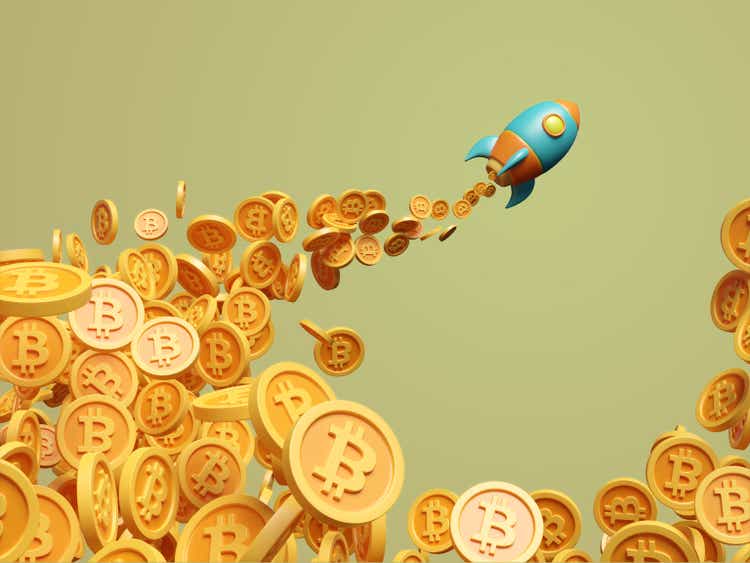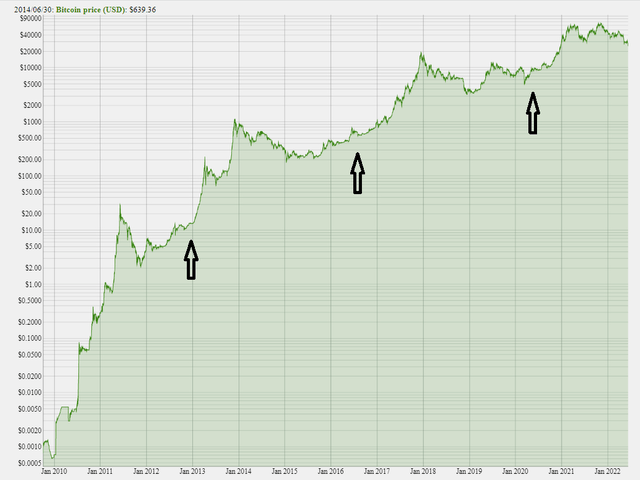BT Series/iStock via Getty Images
It’s starting to seem like the long-term support level for Bitcoin (BTC-USD) might just be zero. But Bitcoin HODLers remain undeterred by this year’s cryptocurrency rout. For them, the current crypto winter must inevitably be followed by the next crypto spring, with the promise of higher highs in the six or even seven digits. A particularly popular narrative is that BTC isn’t “dead” but rather following a four-year cycle driven by an event known as the “halving,” or as some prefer to call it, the “halvening.”
Halving refers to a 50% reduction in the rate at which new BTC supply is put into circulation, a step-down in issuance that occurs every 210,000 blocks, roughly every four years. So far this has happened three times-in 2012, 2016, and 2020-and is next expected in the first half of 2024. (If you’d like a more precise date, check out this “Bitcoin clock.”) Halvings will continue until the last bitcoin is mined, probably in 2040, at which point the supply will be permanently fixed at 21 million.
Bitcoin bulls like to point out that in each of the last three cases a major bottom occurred about a year in advance of the halving and a new all-time high in the following year (see Figure 1). If this pattern is set to repeat, those sitting on big losses now have nothing to worry about. In a few more years, they’ll be sitting on big profits, gleefully gloating on Twitter over all the losers still working dead-end jobs for bum paychecks.
Figure 1. Bitcoin prices (log scale). Arrows indicate the previous halvings on Nov 28, 2012; Jul 9, 2016; and May 11, 2020. (Bitcoin.zorinaq.com, arrows added by the author.)
With a sample size of three (consisting of the last, and so far, only three halvings), however, there isn’t enough data to draw statistically significant conclusions about what will happen next. To be convincing, a story backed by so little evidence requires some supporting explanation. If I told you that Bitcoin followed a “US presidential election cycle” (2012, 2016, and 2020 being election years), you might be convinced, even without knowing why, if I could produce an unbroken record of such occurrences going back to the early years of the Republic. With only Obama, Trump, and Biden to point to, you’d be more likely to say this apparent pattern was just a coincidence if I couldn’t explain how elections are relevant.
Similarly, for the “halving cycle” story to be believable, there would have to be some reason to think that smaller supply increases should be expected to lead to higher prices. There are, in fact, two commonly cited theories of the “halving cycle,” one based on supply, the other on demand. Unfortunately for the bulls, neither makes much sense.
The first is that a fall in the rate at which new supply is added implies excess demand at current prices (see this Investopedia article, for example). This confuses total supply with new supply. Only total supply matters for the supply-demand equilibrium and this is always increasing (and will keep climbing until the 21-million terminal value is reached). It is simply not the case, as Investopedia would have it, that halvings reduce “the number of Bitcoin in circulation.” (See this chart, set on “all time,” if you don’t believe me.) Whether or not prices go up thus depends as much on the rate at which demand is increasing as on the rate at which new supply is falling. In a world where demand was fixed, price would fall continuously as supply increased. It would merely fall more slowly after the change rather than rise.
According to the second theory, the halving itself causes demand to increase as news about the event makes new classes of investors aware of the benefits of investing in Bitcoin (see page 2 of this article, for example). Well, maybe. But why should investors who hadn’t been paying attention previously be expected to start taking an interest in such an obscure aspect of the Bitcoin protocol? A much more plausible idea is that most newcomers jump on the bandwagon when they hear that existing players have been making money, and are not generally reacting to any information beyond what is visible in the price chart. While they might come on board part way through the up move, how these moves get started in the first place, and why they should necessarily be associated with halvings, then remains a mystery.
The bull case becomes even less convincing when you consider that it assumes halvings must necessarily be followed by new all-time highs, a claim that is hard to justify on the basis of either of these two theories. Both imply that each halving should have a weaker impact than the previous one, as the new supply decrease will be an ever-smaller percentage of existing supply and the number of investors remaining to drink the Kool-Aid will continue to dwindle. This is, in fact, what Figure 1 shows-in percentage terms each bull market represents a smaller trough-to-peak increase than the last.
The problem with being long now, even for believers in the cycle, is that a bottom is not expected until the first half of next year (one year prior to the halving). Bitcoin could fall a lot more between now and then. If we subsequently get only a relative high, this might well be below the current price, leaving the HODLer with an even bigger loss than if she had sold today. We might, say, bottom at $10,000 next April, then reach a peak of only $18,000 in 2025 (the post-halving year), over $3,000 below current levels. (These numbers are, of course, for the sake of argument, not predictions.)
None of this is to say that Bitcoin cannot move higher from here or must eventually go to zero. Indeed, following the recent drop in US bond yields, a continuation of this week’s bounce is not unlikely. The tight correlation between crypto and NASDAQ growth stocks makes such a scenario an even better bet in the event that the latter continue to rally.
My point is simply that there is no reason to expect the fourth halving to push BTC to new highs. If you’re going to be long it had better be for some other reason.
The author would like to thank Tim Swanson, Head of Market Intelligence at Clearmatics, for fact checking this article.


Be the first to comment